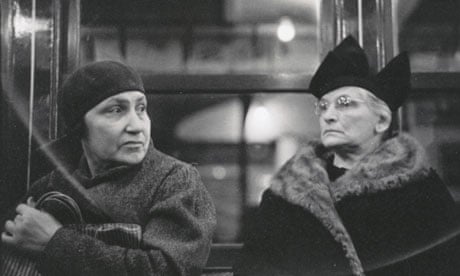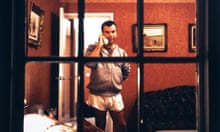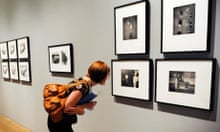As Actaeon was the first to discover, snooping is a serious offence. In Ovid's version of the legend, Diana is bathing in a spring of clear water with her nymphs when Actaeon comes upon her at the end of a day's hunting. He doesn't intend to pry, but he can't help staring, and she's outraged by the intrusion on her privacy. As Ted Hughes retells it, Diana "Raged for a weapon – for her arrows / To drive through his body. / No weapon was to hand – only water. / So she scooped up a handful and dashed it / Into his astonished eyes, as she shouted: / 'Now, if you can, tell how you saw me naked.' / That was all she said, but as she said it / Out of his forehead burst a rack of antlers . . ." Transformed into a stag, Actaeon is hunted down and torn to pieces by his own hounds.
The man who spied on Lady Godiva, and who gave the term Peeping Tom to the language, was punished by being struck blind. As for the Elders who gawped at Susanna bathing, then tried to blackmail her, they were put to death. The paparazzi who spied on Diana's namesake, the Princess of Wales, got off more lightly. But in the aftermath of her death they were accused of brutally hunting her down: insidious stalkers who'd destroyed their innocent prey. It was said in their defence that the princess, unlike her predecessor, hadn't minded being looked at – that she enjoyed bathing in the limelight. But there was blood on their hands nonetheless.
All art involves looking. But some looks are more invasive than others. Where's the line to be drawn? What's allowable and what's exploitative? Is it OK to portray people without them knowing? These questions come up in regard to life writing and documentary films. But it's with photography that they're most contentious, and a major new exhibition at the Tate, Exposed: Voyeurism, Surveillance and the Camera, raises them in relation to images of sex, war and celebrity from the past 150 years.
Modern technology has made voyeurism more sophisticated, through zoom lenses, camera phones and CCTV. But as the curator of the Tate show, Sandra Phillips, argues, the desire to peek into the lives of others is basic to the human species. The pioneers of photography recognised that, using the camera to gain access behind closed doors. Some of their subjects were complicit. In the 1860s, the countess of Castiglione, mistress of Napoleon III, revelled in performing for a professional photographer. But by the end of the century, the fashion was for something less contrived. "Taken Unawares: Snapshots of Celebrated People" was a page in the tabloid Penny Pictorial. Readers welcomed it as proof that the rich and powerful are no different from the rest of us; the rich and powerful disliked it for the same reason.
To take a shot in secret was no easy thing in those days. But from the start photographers proved resourceful. Early portable cameras – known as "detectives" – were disguised as books and parcels, or hidden in canes, umbrellas and shoes. More practical was the vest pocket camera, with a shutter release cable dangling down the sleeve into the hand. Later came false lenses and right-angle viewfinders, with the camera pointing in one direction while the shot was taken in another. Walker Evans used this ploy in the 1930s, while photographing the poor in New Orleans and Mississippi; so did Helen Levitt, on the streets of Harlem. Later, the two of them prowled the New York subway, with Evans's camera concealed inside his overcoat. Uneasy about his sneakthief methods, Evans waited 25 years before publishing the results: "The rude and impudent invasion", had, he hoped, "been carefully softened and partially mitigated by a planned passage of time".
Some photographers justified their furtiveness as a ploy to secure an un-self-conscious pose or as an exercise in social reform. Jacob Riis's photos of the New York underclass in How the Other Half Lives (1890) were intended to highlight hardship and injustice. Lewis Hine tricked his way into mines and factories in order to expose the scandal of child labour. Tom Howard secreted a camera in his trouser leg in order to photograph the electrocution of the murderer Ruth Snyder. Another American, Paul Strand, took photos in the Bowery: his famous portrait of a blind woman – with a number pinned to her dress and a sign denoting her disability hanging from her neck – inspired Evans to take up photography as a career.
Strand's photo is disturbing because it highlights the helplessness of photographic subjects, who can't see what the camera is seeing (and in this case can't see at all). Those accustomed to public scrutiny are more streetwise and can spot a lens almost by instinct. Richard Burton and Elizabeth Taylor, caught canoodling in swimsuits by Marcello Geppetti in 1962, may not have cared that they were being filmed; by then their affair was in the open. And Margaret Thatcher (ousted from office) and Paris Hilton (on her way to face drug charges) were too distraught to worry about hiding their tears when snapped in the back of their cars. But even celebs sometimes crack when their privacy is intruded on – in the Tate show there's a photo of Anita Ekberg's husband Anthony Steel angrily pursuing paparazzi down the street.
Rather than lurking out of sight, some photographers remind us of their presence. When Gary Winogrand snapped a snogging couple in New York in 1969, he was echoing Robert Doisneau's famous shot of a "spontaneous" lovers' kiss in Paris in 1950. But there's an onlooker in the image as well, a girl staring at the camera as if to challenge its presumption; the woman being kissed is staring, too; everyone knows what's going on (whereas Doisneau's couple are professional models pretending not to know). An earlier New York photographer, Weegee, is more surreptitious; his shot of lovers kissing at the movies in 1940 is taken from above. He's as remote as God or Google Earth, and they've no idea they're in the frame.
With pornography, most subjects knowingly perform private acts for public consumption. But an imbalance of power remains. If the models hadn't fallen on hard times, or weren't addicted to hard drugs, would they be willing to expose themselves? Degas both painted and photographed working women as they dried themselves after taking a bath. His models were seamstresses and ballet dancers as well as prostitutes, but all were conscious of their inferior social status; portraying them nude was his droit de seigneur. To judge by the Tate show, most early porn is peekaboo stuff of this kind – the thrill of the illicit. One model stares boldly back while touching herself; others are masked, half-clothed or reflected in mirrors. Either way, the viewer is a guilty voyeur.
A more recent trend has been to show voyeurism in action, with those watching, rather than those watched, the centre of attention. Kohei Yoshiyuki has a series of photos taken in Tokyo parks with infra-red sensitive film and filtered flashbulbs that show spectators sneaking up on couples while they have sex under cover of darkness. In similar vein, Susan Meiselas examines the faces of men leering at a stripper in a bar. These photos echo pictures of Susanna and the Elders, as painted by Rubens, Rembrandt, Tintoretto, Van Dyck and Gentileschi – a story of innocence falling victim to unscrupulous male desire. They point a moral, but they titillate as well.
With violence, as with sex, viewers don't always respond as the artist intends. Just as erotica can fail to arouse desire, so images of death and mayhem can fail to incite revulsion. Included in Exposed are photos of a burial party in the American civil war, the assassinations of John and Robert Kennedy, and assorted lynchings, firing squads, murders, electrocutions, suicide leaps, self‑immolations and mass graves. With war photos (whether Robert Capa's of a soldier falling in the Spanish civil war, or Eddie Adams's of a Viet Cong officer being shot in the head) there's often a suspicion of something being set up or over-elaborately composed. As Susan Sontag puts it: "People want the weight of witnessing without the taint of artistry, which is equated with insincerity." By this measure, Weegee emerges as the major figure of his day, because his photos of New York murders and tenement fires are so brutally frank – artful only in their literalism. Weegee grasped that to move the viewer the photographer must himself remain unmoved. For 10 years he took shots of murder and suicide victims, often arriving at the scene before the police did and noting details with icy clarity (when a woman jumps from a window and lands on the street, he reported, there won't be a mark on her face but usually one of her shoes comes off).
With murder victims and the war dead, permissibility is a sensitive issue: these people haven't consented to be shown as corpses. Press and broadcasting editors may decide that such photos deserve to be shown because they expose the realities of crime or battle and are therefore in the public interest. Photos from the Vietnam war – of the My Lai massacre, for instance – undoubtedly influenced anti-war sentiment. But as Sontag points out in her eloquent essay Regarding the Pain of Others, while images of distress "may spur people to feel they ought to 'care' more", they may also feel "that suffering and misfortune are too vast, too irrevocable, too epic to be much changed". The image of an Iraqi soldier, hideously disfigured after burning to death in a truck, caused a strong reaction when published in the Guardian in 1991, and prompted a long poem from Tony Harrison. But it didn't prevent the 2003 invasion. And it's only enemy soldiers (safely foreign, with families too far away to know or object) who are depicted so starkly; to show the corpses of British troops in current conflict would be deemed disrespectful and in shockingly bad taste.
The camera can't change the world, but there's an idea that it can protect us – hence surveillance, which promises to watch over us, and watch out for us, rather than merely watch. The idea of surveillance has already produced a sizeable body of literature, film and music – Huxley's Brave New World, Orwell's Nineteen Eighty-Four, Hitchcock's Rear Window, Coppola's The Conversation, Henckel von Donnersmarck's The Lives of Others, even the Police song "Every Breath You Take" ("I'll be watching you") – and it's central to photography, too. Some of the first photos were police photos. And it wasn't just convicted criminals whose mugshots were placed on file but anyone who might pose a threat – anarchists, suffragettes, anti-war demonstrators, foreign spies whispering in the street.
The extent to which the state is watching us today would shock even Orwell. And while some photographers have hijacked advances in technology for their own kind of snooping (such as Alair Gomes, training telephoto lenses on muscled young men on the beach, or Merry Alpern taking a videocam into a women's dressing room), others have used old-fashioned landscape shots to depict the insidious spread of surveillance cameras in our suburbs and streets. To the photographer, CCTV is an affront, because it records at random, without human agency; it doesn't know it's bearing witness. And yet, as Sandra Phillips says, certain photos taken for security reasons – aerial reconnaissance shots of missile sites, for example, or the green glow of buildings seen through night-vision goggles – have a strange abstract-expressionist beauty.
Modern surveillance techniques look like the stuff of science fiction. But there's nothing new about the desire to watch someone without them knowing – and nothing unnatural about them being furious if they find out. If Actaeon happened on Diana today, he'd use his camera phone. But if he tried to post the photos on the internet, she'd have her lawyers rip him apart.




Comments (…)
Sign in or create your Guardian account to join the discussion